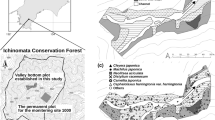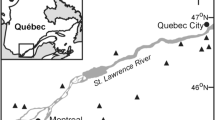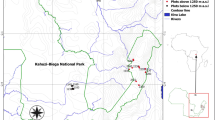Abstract
We studied forest structure, composition and tree species diversity of eight plots in an environmental matrix of four altitudes (700, 1700, 2700 and 3100 m) and two types of geological substrates (ultrabasic and non-ultrabasic rocks) on Mount Kinabalu, Borneo. On both substrate series, forest stature, mean leaf area and tree species diversity (both ≥ 4.8 cm and ≥ 10 cm diameter at breast height [dbh]) decreased with altitude. The two forests on the different substrate series were similar at 700 m in structure, generic and familial composition and tree species diversity, but became dissimilar with increasing altitude. The decline in stature with altitude was steeper on the ultrabasic substrates than on the non-ultrabasic substrates, and tree species diversity was generally lower on ultrabasic substrates than on non-ultrabasic substrates at ≥ 1700 m. The forests on non-ultrabasic substrates at higher altitudes and those on ultrabasic substrates at the lower altitudes were similar in dbh versus tree height allometry, mean leaf area, and generic and familial composition at ≥ 1700 m. These contrasting patterns in forest structure and composition between the two substrate series suggested that altitudinal change was compressed on the ultrabasic substrates compared to the non-ultrabasic substrates. Tree species diversity was correlated with maximum tree height and estimated aboveground biomass, but was not with basal area, among the eight study sites. We suggest that forests with higher tree species diversity are characterized by greater biomass allocation to height growth relative to trunk diameter growth under more productive environment than forests with lower tree species diversity.
Similar content being viewed by others
References
Aiba, S. & Kohyama, T. 1997. Crown architecture and life-history traits of 14 tree species in a warm-temperate rain forest: signifi-cance of spatial heterogeneity. J. Ecol. 85: 611-624.
Aplet, G. & Vitousek, P. M. 1994. An age-altitude matrix analysis of Hawaiian rain-forest succession. J. Ecol. 82: 137-147.
Ash, J. 1987. Stunted cloud-forest in Taveuni, Fiji. Pac. Sci. 41: 191-199.
Ashton, P. S. 1982. Dipterocarpaceae. FloraMalesiana Ser. I 9: 237-552.
Austin, M. P., Ashton, P. S. & Greig-Smith, P. 1972. The application of quantitative methods to vegetation survey. III. A re-examination of rain forest data from Brunei. J. Ecol. 60: 308-324.
Beaman, J. H. & Beaman, R. S. 1990. Diversity and distribution patterns in the flora of Mount Kinabalu. Pp. 147-160. In: Baas, P., Kalkman, K. & Geesink, R. (eds), The plant diversity of Malesia. Kluwer Academic Publishers, Dordrecht.
Bruijnzeel, L. A., Waterloo, M. J., Proctor, J., Kuiters, A. T. & Kotterink, B. 1993. Hydrological observations in montane rain forests on Gunung Silam, Sabah, Malaysia, with special reference to the 'Massenerhebung' effect. J. Ecol. 81: 145-167.
Buckley, R. C., Corlett, R. T. & Grubb, P. J. 1980. Are the xeromorphic trees of tropical upper montane rain forests droughtresistant? Biotropica 12: 124-136.
Cavelier, J. 1996. Environmental factors and ecophysiological processes along altitudinal gradients in wet tropical mountains. Pp. 399-439. In: Mulkey, S. S., Chazdon, R. L. & Smith, A. P. (eds), Tropical forest plant ecophysiology. Chapman & Hall, New York.
Collenette, P. 1964. A short account of the geology and geological history of Mt Kinabalu. Pro. Roy. Soc. B 161: 56-63.
Coomes, D. A. & Grubb, P. J. 1996. Amazonian caatinga and related communities at La Esmeralda, Venezuela: forest structure, physiognomy and floristics, and control by soil factors. Vegetatio 122: 167-191.
Duivenvoorden, J. F. 1996. Patterns of tree species richness in rain forests of the middle Caquetá area, Colombia, NW Amazonia. Biotropica 28: 142-158.
Edwards, P. J. & Grubb, P. J. 1977. Studies of mineral cycling in a montane rain forest in New Guinea. I. The distribution of organic matter in the vegetation and soil. J. Ecol. 65: 943-969.
Fox, J. E. D. 1973. A handbook to Kabili-Sepilok Forest Reserve. Sabah forest record no. 9. Borneo Literature Bureau, Kuchin.
Gentry, A. H. 1988. Changes in plant community diversity and floristic composition on environmental and geographic gradients. Ann. Mo. Bot. Gard. 75: 1-34.
Grubb, P. J. 1971. Interpretation of the 'Massenerhebung effect' on tropical mountains. Nature 229: 44-45.
Grubb, P. J. 1977. Control of forest growth and distribution on wet tropical mountains: with special reference to mineral nutrition. Ann. Rev. Ecol. Syst. 8: 83-107.
Jacobson, G. 1978. Geology. Pp. 101-110. In: Kinabalu, summit of Borneo. The Sabah Society, Kota Kinabalu.
Kira, T. & Shidei, T. 1967. Primary production and turnover of organic matter in different forest ecosystems of theWestern Pacific. Jap. J. Ecol. 17: 70-87.
Kitayama, K. 1991. Vegetation of Mount Kinabalu Park, Sabah, Malaysia. Project paper. East-West Center, Honolulu.
Kitayama, K. 1992. An altitudinal transect study of the vegetation on Mount Kinabalu, Borneo. Vegetatio 102: 149-171.
Kitayama, K. 1995a. Biophysical conditions of the montane cloud forests of Mount Kinabalu, Sabah, Malaysia. Pp. 183-197. In: Hamilton, L. S., Juvik, J. O. & Scatena, F. N. (eds), Tropical montane cloud forests. Springer-Verlag, New York.
Kitayama, K. 1996a. Climate of the summit region of Mount Kinabalu (Borneo) in 1992, an El Niño year. Mountain Res. Devel. 16: 65-75.
Kitayama, K. 1996b. Patterns of species diversity on an oceanic versus a continental island mountain: a hypothesis on species diversification. J. Veg. Sci. 7: 879-888.
Kitayama, K., Aiba, S., Majalap-Lee, N. & Ohsawa, M. 1998. Soil nitrogen meneralization rates of rain forests in a matrix of elevations and geological substrates on Mount Kinabalu, Borneo. Ecol. Res. 13, in press.
Lieberman, D., Lieberman, M., Peralta, R. & Hartshorn, G. 1996. Tropical forest structure and composition on a large-scale altitudinal gradient in Costa Rica. J. Ecol. 84: 137-152.
Marrs, R. H., Proctor, J., Heaney, A. & Mountfield, M. D. 1988. Changes in soils, nitrogen mineralization and nitrification along an altitudinal transect in tropical rain forest in Costa Rica. J. Ecol. 76: 466-482.
Meijer, W. 1965. A botanical guide to the flora of Mt. Kinabalu. Pp. 325-366. In: Symposium on ecological research in humid tropics vegetation. Government of Sarawak and UNESCO, Kuchin.
Nadkarni, N. M., Matelson, T. J. & Haber, W. A. 1995. Structural characteristics and floristic composition of a Neotropical cloud forest, Monteverde, Costa Rica. J. Trop. Ecol. 11: 481-495.
Nagano, M. 1978. Dynamics of stand development. Pp. 21-32. In: Kira, T., Ono, Y. & Hosokawa, T. (eds), Biological production in a warm-temperate evergreen oak forest of Japan. JIBP synthesis vol. 18. University of Tokyo Press, Tokyo.
Nakashizuka, T., Yusop, Z. & Nik, A. R. 1991. Altitudinal zonation of forest communities in Selangor, Peninsular Malaysia. J. Trop. For. Sci. 4: 233-244.
Newbery, D. McC., Campbell, E. J. F., Proctor, J. & Still, M. J. 1996. Primary lowland dipterocarp forest at Danum Valley, Sabah, Malaysia. Species composition and patterns in understorey. Vegetatio 122: 193-220.
Nicholson, D. I. 1965. A study of virgin forest near Sandakan, North Borneo. Pp. 67-87. In: Symposium on ecological research in humid tropics vegetation. Government of Sarawak and UNESCO, Kuchin.
Ogawa, H. 1969. An attempt at classifying forest types based on the relationship between tree height and dbh. Pp. 3-17. In: Kira, T. (ed.), Comparative study of primary productivity in forest ecosystems. JIBP-PT-F progress reports for 1968 (in Japanese).
Ohsawa, M. 1993. Latitudinal pattern of mountain vegetation zonation in southern and eastern Asia. J. Veg. Sci. 4: 13-18.
Ohsawa, M., Nainggolan, P. H. J., Tanaka, N. & Anwar, C. 1985. Altitudinal zonation of forest vegetation onMount Kerinci, Sumatra: with comparison to zonation in the temperate region of east Asia. J. Trop. Ecol. 1: 193-216.
Oksanen, J. & Minchin, P. R. 1997. Instability of ordination results under changes in input data order: explanations and remedies. J. Veg. Sci. 8: 447-454.
Pendry, C. A. & Proctor, J. 1996. The causes of altitudinal zonation of rain forests on Bukit Belalong, Brunei. J. Ecol. 84: 407-418.
Pielou, E. C. 1975. Ecological diversity. Wiley-Interscience, New York.
Proctor, J., Anderson, J. M., Chai, P. & Vallack, H. W. 1983. Ecological studies in four contrasting lowland rain forests in Gunung Mulu National Park, Sarawak. I. Forest environment, structure and floristics. J. Ecol. 71: 237-260.
Proctor, J., Lee, Y. F., Langley, A. M., Munro, W. R. C. & Nelson, T. 1988. Ecological studies on Gunung Silam, a small ultrabasic mountain in Sabah, Malaysia. I. Environment, forest structure and floristics. J. Ecol. 76: 320-340.
Proctor, J. &Woodell, S. R. J. 1975. The ecology of serpentine soils. Adv. Ecol. Res. 9: 255-366.
Raich, J.W., Russell, A. E.&Vitousek, P.M. 1997. Primary productivity and ecosystem development along an elevational gradient on Mauna Loa, Hawaii. Ecology 78: 707-721.
Rice, W. R. 1989. Analyzing tables of statistical tests. Evolution 43: 223-225.
Roberts, B. A. & Proctor, J. 1992. The ecology of areas with serpentinized rocks: a world view. Kluwer Academic Publishers, Dordrecht.
Tanner, E. V. J. 1977. Four montane rain forests of Jamaica: a quantitative characterization of the floristics, the soils and the foliar mineral levels, and a discussion of the interrelations. J. Ecol. 65: 883-918.
Tanner, E. V. J. 1980. Studies on the biomass and productivity in a series of montane rain forests in Jamaica. J. Ecol. 68: 573-588.
ter Braak, C. J. F. 1988. CANOCO-a FORTRAN program for canonical community ordination by [partial] [detrended] [canonical] correlation analysis, principal components analysis and redundancy analysis (version 2.1). TNO Institute of Applied Computer Science, Wageningen.
Tracey, J. G. 1982. The vegetation of the humid tropical region of North Queensland. CSIRO, Melbourne.
Weaver, P. L. & Murphy, P. G. 1990. Forest structure and productivity in Puerto Rico's Luiquillo mountains. Biotropica 22: 69-82.
Webb, L. J. 1959. A physiognomic classification of Australian rain forests. J. Ecol. 47: 551-570.
Whitmore, T. C. 1984. Tropical rain forests of the Far East. 2nd ed. Clarendon Press, Oxford.
Wilson, J. B., Lee, W. G. & Mark, A. F. 1990. Species diversity in relation to ultramafic substrate and to altitude in southwestern New Zealand. Vegetatio 86: 15-20.
Yamada, I. 1977. Forest ecological studies of the montane forest of Mt. Pangrango, West Java. IV. Floristic composition along the altitude. South East Asian Studies 15: 226-254.
Yamakura, T., Hagihara, A., Sukardjo, S. & Ogawa, H. 1986. Aboveground biomass of tropical rain forest stands in Indonesian Borneo. Vegetatio 68: 71-82.
Yamanaka, T. 1959. A phytosociological study of serpentine areas in Shikoku, Japan. Res. Rep. Kochi Univ. 8: 1-47.
Author information
Authors and Affiliations
Rights and permissions
About this article
Cite this article
Aiba, Si., Kitayama, K. Structure, composition and species diversity in an altitude-substrate matrix of rain forest tree communities on Mount Kinabalu, Borneo. Plant Ecology 140, 139–157 (1999). https://doi.org/10.1023/A:1009710618040
Issue Date:
DOI: https://doi.org/10.1023/A:1009710618040




